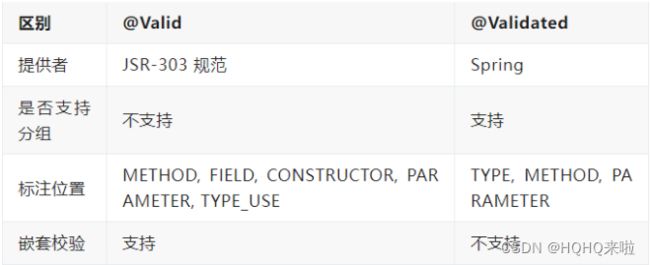Spring Validation参数校验
简单使用
Java API规范 (JSR303) 定义了Bean校验的标准validation-api,但没有提供实现。hibernate validation是对这个规范的实现,并增加了校验注解如@Email、@Length等。Spring Validation是对hibernate validation的二次封装,用于支持spring mvc参数自动校验。接下来,我们以spring-boot项目为例,介绍Spring Validation的使用。
引入依赖
如果spring-boot版本小于2.3.x,spring-boot-starter-web会自动传入hibernate-validator依赖。如果spring-boot版本大于2.3.x,则需要手动引入依赖:
org.hibernate
hibernate-validator
6.0.1.Final
对于web服务来说,为防止非法参数对业务造成影响,在Controller层一定要做参数校验的!大部分情况下,请求参数分为如下两种形式:
-
POST、PUT请求,使用requestBody传递参数; -
GET请求,使用requestParam/PathVariable传递参数。
下面我们简单介绍下requestBody和requestParam/PathVariable的参数校验实战!
requestBody参数校验
POST、PUT请求一般会使用requestBody传递参数,这种情况下,后端使用** DTO 对象进行接收。只要给 DTO 对象加上@Validated注解就能实现自动参数校验**。比如,有一个保存User的接口,要求userName长度是2-10,account和password字段长度是6-20。如果校验失败,会抛出MethodArgumentNotValidException异常,Spring默认会将其转为400(Bad Request)请求。
DTO 表示数据传输对象(Data Transfer Object),用于服务器和客户端之间交互传输使用的。在 spring-web 项目中可以表示用于接收请求参数的Bean对象。
-
在
DTO字段上声明约束注解
@Data
public class UserDTO {
@NotNull @Length(min = 2, max = 10)
private Long userId;
@NotNull @Length(min = 6, max = 20)
private String userName;
private String account;
@NotNull
@Length(min = 6, max = 20)
private String password;
} -
在方法参数上声明校验注解
@PostMapping("/save")
public Result saveUser(@RequestBody @Validated UserDTO userDTO) {
return Result.ok();
} 这种情况下,使用@Valid和@Validated都可以。
requestParam/PathVariable参数校验
GET请求一般会使用requestParam/PathVariable传参。如果参数比较多 (比如超过 6 个),还是推荐使用DTO对象接收。否则,推荐将一个个参数平铺到方法入参中。在这种情况下,**必须在Controller类上标注@Validated注解,并在入参上声明约束注解 (如@Min等)**。如果校验失败,会抛出ConstraintViolationException异常。代码示例如下:
@RequestMapping("/api/user")
@RestController
@Validated
public class UserController {
@GetMapping("{userId}")
public Result detail(@PathVariable("userId") @Min(10000000000000000L) Long userId){
UserDTO userDTO = new UserDTO();
userDTO.setUserId(userId);
userDTO.setAccount("11111111111111111");
userDTO.setUserName("xixi");
userDTO.setAccount("11111111111111111");
return Result.ok(userDTO);
}
@GetMapping("getByAccount")
public Result getByAccount(@Length(min = 6, max = 20) @NotNull String account{
UserDTO userDTO = new UserDTO();
userDTO.setUserId(10000000000000003L);
userDTO.setAccount(account);
userDTO.setUserName("xixi");
userDTO.setAccount("11111111111111111");
return Result.ok(userDTO);
}
} 进阶使用
分组校验
在实际项目中,可能多个方法需要使用同一个DTO类来接收参数,而不同方法的校验规则很可能是不一样的。这个时候,简单地在DTO类的字段上加约束注解无法解决这个问题。因此,spring-validation支持了分组校验的功能,专门用来解决这类问题。还是上面的例子,比如保存User的时候,UserId是可空的,但是更新User的时候,UserId的值必须>=10000000000000000L;其它字段的校验规则在两种情况下一样。这个时候使用分组校验的代码示例如下:
-
约束注解上声明适用的分组信息
groups
@Data
public class UserDTO {
@Min(value = 10000000000000000L, groups = Update.class)
private Long userId;
@NotNull(groups = {Save.class, Update.class})
@Length(min = 2, max = 10, groups = {Save.class, Update.class})
private String userName;
@NotNull(groups = {Save.class, Update.class})
@Length(min = 6, max = 20, groups = {Save.class, Update.class})
private String account;
@NotNull(groups = {Save.class, Update.class})
@Length(min = 6, max = 20, groups = {Save.class, Update.class})
private String password;
public interface Save {
}
public interface Update {
}
} -
@Validated注解上指定校验分组
@PostMapping("/save")
public Result saveUser(@RequestBody @Validated(UserDTO.Save.class) UserDTO userDTO{
return Result.ok();
}
@PostMapping("/update")
public Result updateUser(@RequestBody @Validated(UserDTO.Update.class) UserDTO userDTO) {
return Result.ok();
} 嵌套校验
前面的示例中,DTO类里面的字段都是基本数据类型和String类型。但是实际场景中,有可能某个字段也是一个对象,这种情况先,可以使用嵌套校验。
比如,上面保存User信息的时候同时还带有Job信息。需要注意的是,此时DTO类的对应字段必须标记@Valid注解。
@Data
public class UserDTO {
@Min(value = 10000000000000000L, groups = Update.class)
private Long userId;
@NotNull(groups = {Save.class, Update.class})
@Length(min = 2, max = 10, groups = {Save.class, Update.class})
private String userName;
@NotNull(groups = {Save.class, Update.class})
@Length(min = 6, max = 20, groups = {Save.class, Update.class})
private String account;
@NotNull(groups = {Save.class, Update.class})
@Length(min = 6, max = 20, groups = {Save.class, Update.class})
private String password;
@NotNull(groups = {Save.class, Update.class})
@Valid
private Job job;
@Data
public static class Job {
@Min(value = 1, groups = Update.class)
private Long jobId;
@NotNull(groups = {Save.class, Update.class})
@Length(min = 2, max = 10, groups = {Save.class, Update.class})
private String jobName;
@NotNull(groups = {Save.class, Update.class})
@Length(min = 2, max = 10, groups = {Save.class, Update.class})
private String position;
}
public interface Save {
}
public interface Update {
}
} 嵌套校验可以结合分组校验一起使用。还有就是嵌套集合校验会对集合里面的每一项都进行校验,例如List字段会对这个list里面的每一个Job对象都进行校验。
集合校验
如果请求体直接传递了json数组给后台,并希望对数组中的每一项都进行参数校验。此时,如果我们直接使用java.util.Collection下的list或者set来接收数据,参数校验并不会生效!我们可以使用自定义list集合来接收参数:
-
包装
List类型,并声明@Valid注解
public class ValidationList implements List {
@Delegate
@Valid
public List list = new ArrayList<>();
@Override
public String toString() {
return list.toString();
}
} @Delegate注解受lombok版本限制,1.18.6以上版本可支持。如果校验不通过,会抛出NotReadablePropertyException,同样可以使用统一异常进行处理。
比如,我们需要一次性保存多个User对象,Controller层的方法可以这么写:
@PostMapping("/saveList")
public Result saveList(@RequestBody @Validated(UserDTO.Save.class) ValidationList userList) {
return Result.ok();
} 自定义校验
业务需求总是比框架提供的这些简单校验要复杂的多,我们可以自定义校验来满足我们的需求。自定义spring validation非常简单,假设我们自定义加密id(由数字或者a-f的字母组成,32-256长度)校验,主要分为两步:
-
自定义约束注解
@Target({METHOD, FIELD, ANNOTATION_TYPE, CONSTRUCTOR, PARAMETER})
@Retention(RUNTIME)
@Documented
@Constraint(validatedBy = {EncryptIdValidator.class})
public @interface EncryptId {
String message() default "加密id格式错误";
Class[] groups() default {};
Class[] payload() default {};
} -
实现
ConstraintValidator接口编写约束校验器
public class EncryptIdValidator implements ConstraintValidator {
private static final Pattern PATTERN = Pattern.compile("^[a-f\\d]{32,256}$");
@Override
public boolean isValid(String value, ConstraintValidatorContext context) {
if (value != null) {
Matcher matcher = PATTERN.matcher(value);
return matcher.find();
}
return true;
}
} 这样我们就可以使用@EncryptId进行参数校验了!
编程式校验
上面的示例都是基于注解来实现自动校验的,在某些情况下,我们可能希望以编程方式调用验证。这个时候可以注入javax.validation.Validator对象,然后再调用其api。
@Autowired
private javax.validation.Validator globalValidator;
@PostMapping("/saveWithCodingValidate")
public Result saveWithCodingValidate(@RequestBody UserDTO userDTO) {
Set> validate = globalValidator.validate(userDTO, UserDTO.Save.class);
if (validate.isEmpty()) {
} else {
for (ConstraintViolation userDTOConstraintViolation : validate) {
System.out.println(userDTOConstraintViolation);
}
}
return Result.ok();
} 快速失败 (Fail Fast)
Spring Validation默认会校验完所有字段,然后才抛出异常。可以通过一些简单的配置,开启Fali Fast模式,一旦校验失败就立即返回。
实现原理
requestBody参数校验实现原理
在spring-mvc中,RequestResponseBodyMethodProcessor是用于解析@RequestBody标注的参数以及处理@ResponseBody标注方法的返回值的。显然,执行参数校验的逻辑肯定就在解析参数的方法resolveArgument()中:
public class RequestResponseBodyMethodProcessor extends AbstractMessageConverterMethodProcessor {
@Override
public Object resolveArgument(MethodParameter parameter, @Nullable ModelAndViewContainer mavContainer,
NativeWebRequest webRequest, @Nullable WebDataBinderFactory binderFactory) throws Exception {
parameter = parameter.nestedIfOptional();
Object arg = readWithMessageConverters(webRequest, parameter, parameter.getNestedGenericParameterType());
String name = Conventions.getVariableNameForParameter(parameter);
if (binderFactory != null) {
WebDataBinder binder = binderFactory.createBinder(webRequest, arg, name);
if (arg != null) {
validateIfApplicable(binder, parameter);
if (binder.getBindingResult().hasErrors() && isBindExceptionRequired(binder, parameter)) {
throw new MethodArgumentNotValidException(parameter, binder.getBindingResult());
}
}
if (mavContainer != null) {
mavContainer.addAttribute(BindingResult.MODEL_KEY_PREFIX + name, binder.getBindingResult());
}
}
return adaptArgumentIfNecessary(arg, parameter);
}
} 可以看到,resolveArgument()调用了validateIfApplicable()进行参数校验。
protected void validateIfApplicable(WebDataBinder binder, MethodParameter parameter) {
Annotation[] annotations = parameter.getParameterAnnotations();
for (Annotation ann : annotations) {
Validated validatedAnn = AnnotationUtils.getAnnotation(ann, Validated.class);
if (validatedAnn != null || ann.annotationType().getSimpleName().startsWith("Valid")) {
Object hints = (validatedAnn != null ? validatedAnn.value() : AnnotationUtils.getValue(ann));
Object[] validationHints = (hints instanceof Object[] ? (Object[]) hints : new Object[] {hints});
binder.validate(validationHints);
break;
}
}
} 看到这里,大家应该能明白为什么这种场景下@Validated、@Valid两个注解可以混用。我们接下来继续看WebDataBinder.validate()实现。
@Override
public void validate(Object target, Errors errors, Object... validationHints) {
if (this.targetValidator != null) {
processConstraintViolations(
this.targetValidator.validate(target, asValidationGroups(validationHints)), errors);
}
} 最终发现底层最终还是调用了Hibernate Validator进行真正的校验处理。
方法级别的参数校验实现原理
上面提到的将参数一个个平铺到方法参数中,然后在每个参数前面声明约束注解的校验方式,就是方法级别的参数校验。实际上,这种方式可用于任何Spring Bean的方法上,比如Controller/Service等。其底层实现原理就是AOP,具体来说是通过MethodValidationPostProcessor动态注册AOP切面,然后使用MethodValidationInterceptor对切点方法织入增强。
public class MethodValidationPostProcessor extends AbstractBeanFactoryAwareAdvisingPostProcessorimplements InitializingBean {
@Override
public void afterPropertiesSet() {
Pointcut pointcut = new AnnotationMatchingPointcut(this.validatedAnnotationType, true);
this.advisor = new DefaultPointcutAdvisor(pointcut, createMethodValidationAdvice(this.validator));
}
protected Advice createMethodValidationAdvice(@Nullable Validator validator) {
return (validator != null ? new MethodValidationInterceptor(validator) : new MethodValidationInterceptor());
}
} 接着看一下MethodValidationInterceptor:
public class MethodValidationInterceptor implements MethodInterceptor {
@Override
public Object invoke(MethodInvocation invocation) throws Throwable {
if (isFactoryBeanMetadataMethod(invocation.getMethod())) {
return invocation.proceed();
}
Class[] groups = determineValidationGroups(invocation);
ExecutableValidator execVal = this.validator.forExecutables();
Method methodToValidate = invocation.getMethod();
Set> result;
try {
result = execVal.validateParameters(
invocation.getThis(), methodToValidate, invocation.getArguments(), groups);
}
catch (IllegalArgumentException ex) {
...
}
if (!result.isEmpty()) {
throw new ConstraintViolationException(result);
}
Object returnValue = invocation.proceed();
result = execVal.validateReturnValue(invocation.getThis(), methodToValidate, returnValue, groups);
if (!result.isEmpty()) {
throw new ConstraintViolationException(result);
}
return returnValue;
}
} 实际上,不管是requestBody参数校验还是方法级别的校验,最终都是调用Hibernate Validator执行校验,Spring Validation只是做了一层封装。
